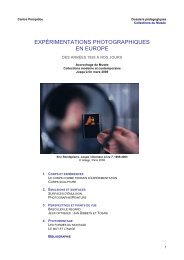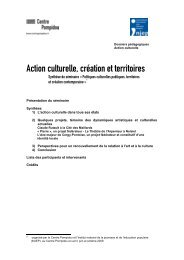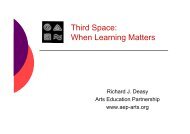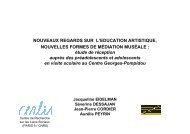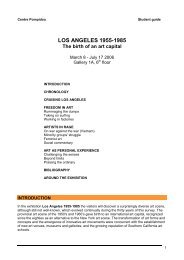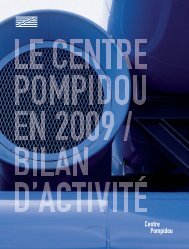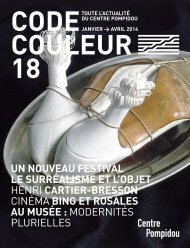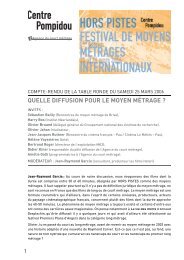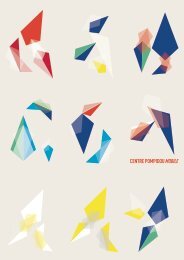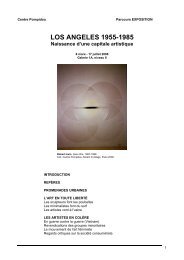to download the PowerPoint presentation - Centre Pompidou
to download the PowerPoint presentation - Centre Pompidou
to download the PowerPoint presentation - Centre Pompidou
- No tags were found...
Create successful ePaper yourself
Turn your PDF publications into a flip-book with our unique Google optimized e-Paper software.
Evaluating <strong>the</strong> Impact ofArts EducationPosing pertinent questions, employing suitable <strong>to</strong>olsLarry O’FarrellOQueen’s s UniversityKings<strong>to</strong>n, Canada
Focus on InstrumentalOutcomes Literate in ano<strong>the</strong>r domain Perception of <strong>the</strong> world Interpersonal skills Motivation Creative and critical thinking Ma<strong>the</strong>matical scores Etc.
Research Challenges Lack of large-scale, reliable data Diverse philosophies Lack of agreement on definitions Need for evaluation <strong>to</strong> focus onspecifics of arts education practice Need for appropriate evaluationstrategies
Quantitative methodology Can produce generalized results Measure and analyze relationshipsbetween and among variables Produce statistical relationships Test a <strong>the</strong>ory using variables Must control for all variables
Interest in Specifics “Most of all, can we, who areinterested in what <strong>the</strong> <strong>the</strong>atrical ando<strong>the</strong>r arts offer those children,imagine a research program that is notguided exclusively by scientificpremises, principles and proceduresbut sometimes built upon a realappreciation of what art itself canprovide?”Barone 1997
Qualitative Methodology Detailed observation + rigorousanalysis Field notes, interviews, documents,focus groups, pho<strong>to</strong>graphy, recordings Produces a richly detailed descriptionof <strong>the</strong> arts program Gives a voice <strong>to</strong> <strong>the</strong> participants
Criticism of QuantitativeParadigm Post-positivist critics see quantitativeparadigm as modernist, positivist Discredit modernism’s s grand narrative Feminist writers question modernistassumption of objectivity in science “.. . . we must change <strong>the</strong> social andpolitical context in which science isdone.”Longino 2005
Pragmatic Compromise Reject apparent dicho<strong>to</strong>my “Both science and constructivism offerdifferent sets of <strong>to</strong>ols . . .”.Bradley 2003 Reject primacy for one methodology “What we have <strong>to</strong> do is make <strong>the</strong>technical and humanistic strands inmodern thought work <strong>to</strong>ge<strong>the</strong>r . . .”.Toulman 1997
Seeking a Balance International research in<strong>to</strong> creativity indrama/<strong>the</strong>atre education McCammon,O’Farrell & Saebo in press Diversity of thinking Creativity in curriculum documents Teachers’ understandings Application in teaching (case studies) Option of a quasi-experimental study
No “Quick Fix” Growing body of evidence Researchers must highlight particularforms and approaches Select from among a range ofresearch <strong>to</strong>ols Critical awareness that methodsrepresent diverse cultural imperatives
Thank you.



